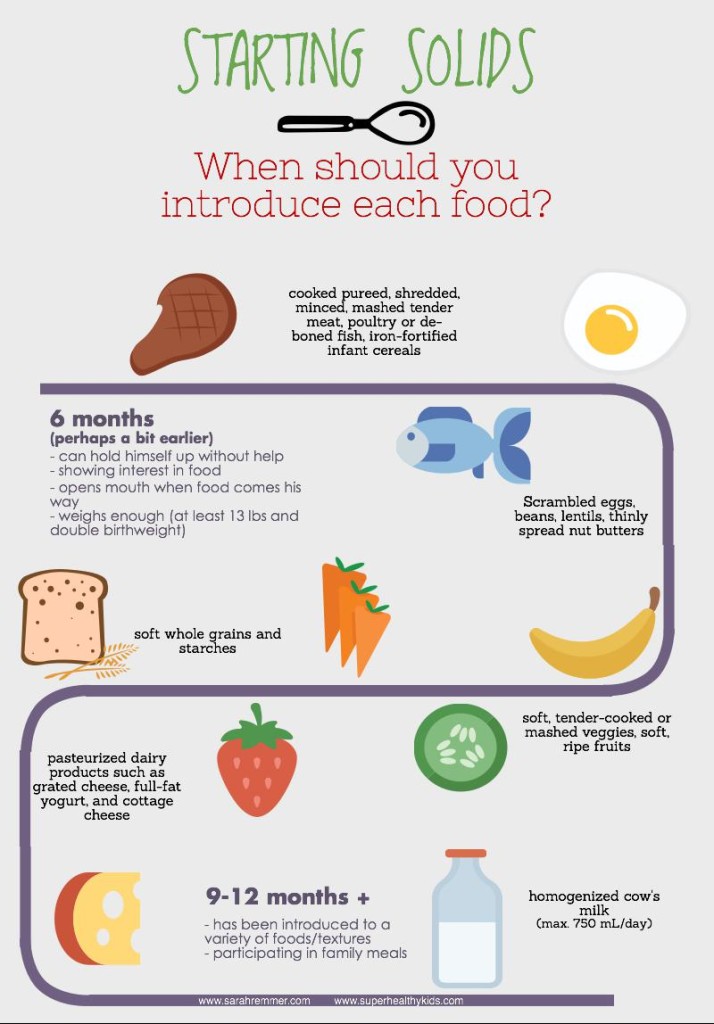Starting solids can seem overwhelming for a new parent (or even a second or third-time parent!), especially when you’re overloaded with conflicting information about what, when, and how to do it.
You might be wondering things like:
- Should I introduce iron-fortified rice cereal first, OR red meat like my friend did?
- Are purees best, or are should I do “baby-led weaning” (soft finger foods) instead?
- Should I start solids at four months, or six months?
- What about nuts and egg whites? Don’t I have to wait a year to introduce those because they’re allergenic?
I get it – it’s confusing.
Luckily, the Canadian infant feeding guidelines have been updated recently with recommendations that support the newest and best research that we have on infant feeding to date (and new American infant feeding guidelines will be included in the updated 2020 dietary guidelines for Americans). Because you’re a busy parent and might not have the time to read through the entire set of guidelines, I’ve highlighted the basics for you, according to the new Canadian Guidelines.”
Starting Solids 101:
When to introduce solids:
It is recommended that real food be introduced around six months of age, as breastmilk (and/or formula) can provide 100% of baby’s nutrition up to that point. The WHO (World Health Organization) estimates that solid foods provide about one fifth of a baby’s energy needs from six to eight months and just under half of baby’s energy needs from nine to 12 months. Breastmilk and/or formula will continue to provide the bulk of your baby’s nutritional needs until one year.
Timing is important. You don’t want to start too early or too late. There is a “sweet-spot” window of opportunity around six months that seems to be the best time to start solids. To know when exactly to start between these ages, it’s important to pay attention to your baby’s cues and introduce solids when he is ready:
- He can hold his head up on his own: Your baby should be able to sit in a high chair, feeding seat, or infant seat with good head control and be able to hold himself up.
- He opens his mouth when food comes his way: Babies may be ready if they watch you eating, reach for your food, and seem eager to eat.
- He can maneuver food from a spoon to the back of his throat: If you offer a spoonful, and he pushes it out of his mouth and it dribbles onto his chin (the tongue thrust reflex), he may not be ready yet. You could try diluting it the first few times, then gradually thicken the texture, or you may also want to wait a week or two and try again.
- He’s big enough: If your baby has at least doubled his birth weight and weighs at least 13 pounds , he may be ready to start solids.
Why you shouldn’t start too early or too late:
A baby’s ability to manage and safely swallow solid foods is not developed before about six months (however, some babies are ready in their fourth and fifth month). This is partly due to the fact that her gag reflex hasn’t fully developed, putting her at an increase risk of choking. Her digestive tract has also not developed to the point of being able to digest the nutrients in real food either. On the other hand, starting later than six months (unless advised by baby’s pediatrician) might make the transition to real food more challenging and create picky eating issues. It also puts a breastfed infant at risk for iron-deficiency anemia. This is why baby’s first solid foods should be iron-rich.

Are purees still the way to go?
By six months, most babies are ready for a variety of food textures, ranging from thin purees to soft finger foods. It’s really up to the parent and their level of comfort. Some babies prefer to be spoon-fed purees at the start, while some prefer to dig into soft finger foods right at the get-go.
Because older babies quickly develop up and down jaw movements enabling them to “munch” (even without teeth), it’s not necessary to start with thinly pureed foods first (think infant cereal thinned out with breastmilk), like previously thought. In fact, there may be many benefits to starting with lumpier textures. Offering soft finger foods will encourage self-feeding (reaching out, grabbing and munching on food), which helps with oral motor development, and allows babies to be in full control of how much and at what pace they eat, helping with eating self-regulation later on.
You can experiment with various textures (lumpy, and tender-cooked and finely minced, pureed, mashed or ground) to see what your baby prefers best and even feed her a variety of textures daily. By nine months, your baby should be eating a variety of foods and textures and ideally participating in family meals! Family foods may need to be modified in texture for your baby (they need to be soft enough) and free of added seasonings such as salt.
Between eight and 12 months of age, babies develop a lateral movements of the tongue, enabling them to eat foods that are more solid and need chewing.
Safe finger foods include: pieces of soft-cooked vegetables and fruits; soft, ripe fruit such as banana; finely minced, ground or mashed cooked meat, deboned fish, and poultry; grated cheese; and whole grain toast strips with a thin layer of butter or nut butter.
Choking hazards:
Hard, small, round foods, as well as smooth and sticky solid foods can block your baby’s airway. It’s recommended that foods such as hard candies, cough drops, gum, whole grapes, popcorn, marshmallows, nuts, fish with bones, hotdogs and sausages aren’t served to children under the age of four years. Make sure that hard vegetables such as carrots are grated or steamed, pits are removed from fruits, grapes are cut in half, nut butters are thinly spread, and stringy foods such as pineapple or celery are finely chopped.
Let your baby lead the way:
Regardless of which texture you start with, it’s important to let your baby lead. This means, either allowing her to self-feed and eat how much she wants (without coaxing her to eat more or taking food away when she’s not done), or paying close attention to her cues while spoon-feeding.Your baby will let you know when she’s done eating by swatting at the spoon, turning her head away, zipping her lips tightly, spitting food out, throwing food, whining or crying. Don’t make her eat more than she wants. Kids will eat when they’re hungry and stop when they’re full. Honoring those instincts may help them avoid overeating now and down the road.
What should I start with?
Iron-rich foods should be introduced right from the get-go, as your baby’s iron needs increase around this time. Babies between six and 12 months of age should be offered iron-rich foods at least twice a day. Soft and tender pieces of meat or finely minced, ground or mashed cooked meat, de-boned fish, poultry, well-cooked whole egg, beans, and lentils are great first foods. Traditionally, iron-fortified single-grain cereal thinned out with breastmilk or formula was the gold-standard first-food for baby. Although it’s still a fine option, it is no longer the only starter-food option.
Vegetables and fruits can follow, in no particular order, as well as whole grain foods, natural nut and seed butters and pasteurized dairy products (with the exception of fluid cow’s milk). Between nine and 12 months, it’s safe to introduce homogenized cow’s milk (with a maximum of 750 mL per day).
What about introducing common food allergens?
We now know that delaying the introduction of common allergens such as eggs, nut butters and fish, isn’t necessary and that it is safe to introduce them as early as six months, even for babies at a high risk of developing a food allergy. In fact, early exposure to common allergens may even prevent allergies from developing!
How often should I be feeding my baby?
From six to eight months, parents should gradually work towards offering solid foods two to three times a day ( at mealtimes), and one to two snacks per day, depending on the baby’s appetite. Your baby’s appetite will vary from day to day depending on several factors such as:
- how they are feeling
- whether there are distractions present
- the time of day
- their breastmilk/formula intake
- whether or not they are going through a growth spurt
- the types of foods they are eating
Take the pressure off:
The first weeks and months of solid foods are supposed to be fun–it’s an experimental period where your baby is introduced to a wide variety of foods, flavours and textures so that he accepts them readily later on. Touching, licking, mushing, playing with, and even spitting foods out is all part of the process of learning to like new foods—it’s completely normal. Try not to get discouraged if your baby doesn’t eat like a champ right at the beginning. Be patient and keep introducing foods in a non-pressured way–he will learn to eat well in his own time and at his own pace. Happy feeding!
SOURCE: http://www.superhealthykids.com










